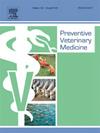蓝舌病血清型3在流行第一年对荷兰牛死亡率、流产和早产的影响
IF 2.2
2区 农林科学
Q1 VETERINARY SCIENCES
引用次数: 0
摘要
2023年9月,在荷兰的羊和牛中发现了蓝舌病病毒血清3型(BTV-3)。在羊和牛中报告了严重的临床症状和死亡率增加。本研究的目的是量化BTV-3对2023年荷兰牛的死亡率、流产和早产的影响。数据可从2020年1月1日至2023年12月31日获得,并按群月水平汇总。每个畜群月分配一个BTV-3状态:1)报告BTV-3临床症状的畜群,2)未报告临床症状但位于BTV-3感染区的畜群,或3)位于BTV-3无区(所有没有BTV-3报告的地区)的畜群。采用多变量种群平均广义估计方程模型来量化BTV-3流行与牛死亡率、流产和早产之间的关系。结果表明,从2023年9月至2023年底,报告BTV-3疫情的奶牛群和位于疫区的其他奶牛群的围产期小牛死亡率分别增加了1.11倍(95 % CI: 1.06-1.16)和1.07倍(95 % CI: 1.05-1.09)。早产可能是小牛死亡率增加的原因之一,与无BTV-3地区的奶牛群相比,通报BTV-3爆发的奶牛群早产的优势比为1.39(95 % CI: 1.26-1.54)。受感染奶牛群的流产率是未感染奶牛群的1.1倍(95 %CI: 1.02-1.20)。在受感染的奶牛群中,1-2岁和2岁以上牛的死亡率分别增加了2.25倍(95 %CI: 1.97-2.58)和1.71倍(95 %CI: 1.62-1.81)。在BTV-3疫区未通报的奶牛群中,与无BTV-3疫区相比,死亡率分别增加了1.17倍(95 %CI: 1.07-1.27)和1.22倍(95 %CI: 1.19-1.25)。此外,通报发生BTV-3疫情的乳牛群、肉牛群和小规模非奶牛群在BTV-3疫情期间的死亡率明显高于无BTV-3地区的牛群。总之,BTV-3感染显著增加了牛群的流产、死亡率和早产。本文章由计算机程序翻译,如有差异,请以英文原文为准。
The impact of bluetongue serotype 3 on cattle mortality, abortions and premature births in the Netherlands in the first year of the epidemic
In September 2023, bluetongue virus serotype 3 (BTV-3) was identified among sheep and cattle in the Netherlands. Severe clinical signs and increased mortality were reported in sheep and cattle. The aim of this study was to quantify the impact of BTV-3 on mortality, abortions and premature births in cattle in the Netherlands in 2023. Data were available from 1 January 2020–31 December 2023 and were aggregated at herd-month level. Cattle herds were assigned a BTV-3 status for each herd-month: 1) herds that notified clinical signs of BTV-3, 2) herds that did not notify clinical signs but were located in BTV-3 infected areas or 3) herds that were located in BTV-3 free areas (all areas without BTV-3 notifications). Multivariable population-averaged generalized estimating equations models were used to quantify the association between the BTV-3 epidemic and cattle mortality, abortions and premature births. The results showed that from September 2023 until the end of 2023, perinatal calf mortality increased 1.11 (95 % CI:1.06–1.16) and 1.07 (95 % CI: 1.05–1.09) times, in dairy herds with a notified BTV-3 outbreak and in other dairy herds located in outbreak areas, respectively. Premature birth may be one of the explanations of increased calf mortality, as suggested by an odds ratio of 1.39 (95 % CI: 1.26–1.54) for premature births in dairy herds with a notified BTV-3 outbreak compared to dairy herds in BTV-3 free areas. The odds of abortions in infected dairy herds was 1.1 (95 %CI: 1.02–1.20) times higher compared to non-infected herds. Mortality in cattle aged 1–2 years and older than 2 years increased 2.25 (95 %CI: 1.97–2.58) and 1.71 (95 % CI: 1.62–1.81) times respectively, in infected dairy herds. In dairy herds without notification located in BTV-3 infected areas, mortality increased by 1.17 (95 %CI: 1.07–1.27) and 1.22 (95 % CI: 1.19–1.25) times respectively, compared to herds in BTV-3 free areas. In addition, suckler cow herds, beef cattle herds and small scale non-dairy cattle herds with a notified BTV-3 outbreak showed a significantly increased mortality during the BTV-3 epidemic compared to herds in BTV-3 free areas. In conclusion, BTV-3 infections markedly increased abortions, mortality and premature births in cattle herds.
求助全文
通过发布文献求助,成功后即可免费获取论文全文。
去求助
来源期刊

Preventive veterinary medicine
农林科学-兽医学
CiteScore
5.60
自引率
7.70%
发文量
184
审稿时长
3 months
期刊介绍:
Preventive Veterinary Medicine is one of the leading international resources for scientific reports on animal health programs and preventive veterinary medicine. The journal follows the guidelines for standardizing and strengthening the reporting of biomedical research which are available from the CONSORT, MOOSE, PRISMA, REFLECT, STARD, and STROBE statements. The journal focuses on:
Epidemiology of health events relevant to domestic and wild animals;
Economic impacts of epidemic and endemic animal and zoonotic diseases;
Latest methods and approaches in veterinary epidemiology;
Disease and infection control or eradication measures;
The "One Health" concept and the relationships between veterinary medicine, human health, animal-production systems, and the environment;
Development of new techniques in surveillance systems and diagnosis;
Evaluation and control of diseases in animal populations.
 求助内容:
求助内容: 应助结果提醒方式:
应助结果提醒方式:


